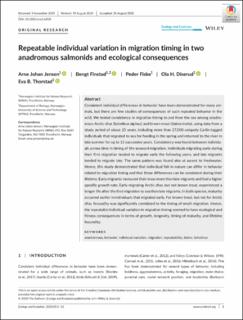Repeatable individual variation in migration timing in two anadromous salmonids and ecological consequences
Peer reviewed, Journal article
Published version

Åpne
Permanent lenke
https://hdl.handle.net/11250/2682783Utgivelsesdato
2020Metadata
Vis full innførselSamlinger
- Publikasjoner fra CRIStin - NINA [2364]
- Scientific publications [1392]
Originalversjon
10.1002/ece3.6808Sammendrag
Consistent individual differences in behavior have been demonstrated for many animals, but there are few studies of consequences of such repeated behavior in the wild. We tested consistency in migration timing to and from the sea among anadromous Arctic char (Salvelinus alpinus) and brown trout (Salmo trutta), using data from a study period of about 25 years, including more than 27,000 uniquely Carlin‐tagged individuals that migrated to sea for feeding in the spring and returned to the river in late summer for up to 13 successive years. Consistency was found between individuals across time in timing of the seaward migration. Individuals migrating early during their first migration tended to migrate early the following years, and late migrants tended to migrate late. The same pattern was found also at ascent to freshwater. Hence, this study demonstrated that individual fish in nature can differ in behavior related to migration timing and that these differences can be consistent during their lifetime. Early migrants increased their mass more than late migrants and had a higher specific growth rate. Early migrating Arctic char, but not brown trout, experienced a longer life after the first migration to sea than late migrants. In both species, maturity occurred earlier in individuals that migrated early. For brown trout, but not for Arctic char, fecundity was significantly correlated to the timing of smolt migration. Hence, the repeatable individual variation in migration timing seemed to have ecological and fitness consequences in terms of growth, longevity, timing of maturity, and lifetime fecundity.
